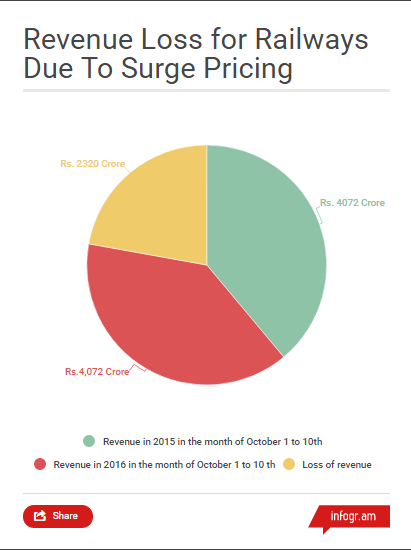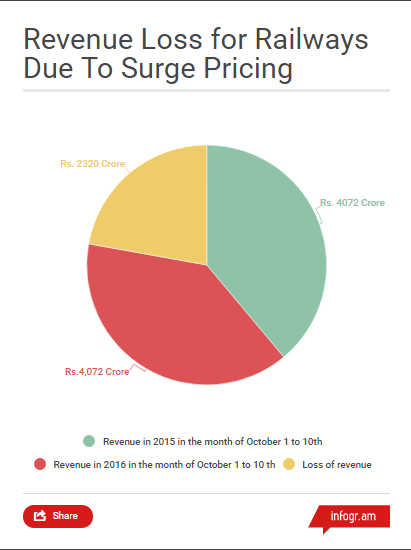
Railways’ Surge Pricing Scheme To Increase Revenue Backfires As It Sustains A Loss Of Rs 232 crore
26 Oct 2016 7:30 AM GMT
The flexi-fare scheme of surge pricing by Indian railways in premium trains to increase the revenue of railways has put up a flop show. Despite surge pricing in Rajdhani, Shatabdi and Duronto Express trains during the festive season, the revenue collection in the first half of October showed a steep decline by Rs 232 crore as compared to previous year.
Trend likely to continue
Such a trend is likely to continue during the winter vacations, Christmas and New Year as a majority of seats of Rajdhani and Shatabdi is going to remain vacant for the months of December and January. These include trains to destinations like Goa, Kerala, Mumbai, Kolkata, Amritsar, Lucknow and Chennai.
Drop in number of passengers
Railway passenger ticket booking fell by 12 per cent with 16.5 lakh fewer passengers travelling by train compared to last year during October 1-10. Railway Minister Suresh Prabhu, however has asked his officials not to jump to any conclusion as he knows that passengers are getting flight tickets at a cheaper rate. The railway ministry will review the scheme only after three months.
Significant loss of revenue
Data shows railways earned Rs 4,072 crore from October 1 to 10 this year which declined by Rs 232 crore in 2015-16. Last year, railways’ revenue during this period was Rs 4,304 crore. The ministry was expecting to garner Rs 1,000 crore from the surge pricing in one year of which Rs 200 crore was expected in the month of October alone.
Trains like Mumbai Rajdhani, August Kranti Rajdhani, Sealdah Rajdhani and Trivandrum Rajdhani that used to have a long waiting list are running with many vacant seats as the airlines are offering tickets to destinations like Goa, Mumbai and Kochi at prices as low as Rs 3,000. The same is the case with the Shatabdi trains to places like Amritsar, Lucknow and Bhopal having low occupancy as the people are preferring to travel by other trains not brought under the surge pricing scheme.
India Today reported, a comprehensive data also shows that railways’ income from all sources has reduced by Rs 3,854 crore so far this financial year. This includes income from freight which is a major source of railways’ revenue. During the first six months of 2015-16, the railways had collected Rs 84,747 crore but this year the income has reduced to Rs 80,893 crore during the same period.


What is flexi-fare scheme?
Under the flexi-fare scheme the base fares of premium trains increase by 10 percent with every 10 percent of berths sold subject to a prescribed ceiling limit. The fares may hike up to 50 per cent in Rajdhani, Shatabdi and Duronto trains. The flexifare system is applicable in AC 2 tier, AC 3 tier, and AC chair car in the three trains, besides sleeper class in Duronto express trains. First AC and Executive Class have been kept out of the new system because of its prevailing high tariffs.
 All section
All section













